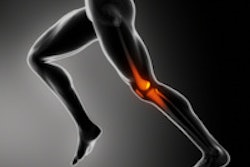
Telemedicine is a powerful and disruptive force in today's healthcare system. For sonographers and others on the front lines of healthcare, telemedicine can be stressful, challenging, and a big change. But it can also offer some of the very best moments for a healthcare worker.
I read with great interest an article titled "Study: Telehealth can be disruptive, threatening for nurses" by Laura Pedulli in the April 22 Ultrasound SmartBrief newsletter from the American Registry for Diagnostic Medical Sonography (ARDMS). Reprinted from Clinical Innovation + Technology, the article cited recent U.K. research that showed telehealth can be disruptive and threatening to staff. As a result, the researchers concluded that management needs to develop strategies to minimize these effects. I have a few thoughts on the topic, but first let me share some information about my background to help you understand my point of view.
 Sonographer Doug Wuebben and his daughter.
Sonographer Doug Wuebben and his daughter.
For the past 15 years, I have been an echocardiographer -- that is, I do cardiac ultrasound. I am registered by ARDMS in both adult and pediatric echocardiography. I became involved in telehealth early in my career. When I was hired at my current position in South Dakota, there was a need for a pediatric echocardiographer. I gladly accepted the challenge and worked very hard not only to pass my boards, but also to become very good at what I do.
The rural nature of a state such as South Dakota can pose many challenges to healthcare; however, telemedicine can make rural areas feel smaller and facilitate the delivery of high-quality, specialized care that would be found at a larger urban healthcare system. My pediatric echo studies involved telemedicine.
Benefits
The benefits of telehealth were immediately apparent. I was able to plug my ultrasound machine into the telemedicine unit, which in turn allowed my study to be reviewed remotely; whatever was seen on the ultrasound machine's screen was also seen by the pediatric cardiologist on the other end.
A pediatric cardiologist would remotely view my study "live" and see things exactly how I saw them in real-time. This was done over our system network and accomplished several incredible things:
- Quick performance. A technician didn't have to drive more than an hour to our site, complete the study, and drive back.
- Instant results. Everyone involved immediately knew the study results.
- Clinical effectiveness. Because information was obtained "live," decisions could be made quickly about the clinical course for the patient. Most of the time, this meant reassurance, observation, and a clinic visit down the road for the parents and patient. Unfortunately, there were also some clinical situations that involved an urgent flight to a more advanced tertiary facility. Telehealth enabled immediate, conclusive answers, including which tertiary facility could best handle the situation.
- Parent education. Even with the most urgent pediatric diagnosis requiring transfer, parents could be consoled and educated about what was going to happen. Sometimes knowledge is power, and even the worst news will help you prepare for the battle ahead.
- Brought remote doctors to bedside. The power of telemedicine enables doctors to be in two places at once and provided the best of care, just as if they were bedside.
- Lifesaving information. Back in 2004, I wrote an article called "The sound of success in telemedicine" (ADVANCE for Imaging and Radiation Therapy Professionals, April 19, 2004, Vol. 17:9). It detailed a specific case in which the timeliness, accuracy, and willingness to incorporate telemedicine literally allowed a newborn's life to be saved. Thanks to a quick diagnosis, proper onsite treatment, and an urgent transfer to the proper tertiary facility, the newborn survived.
Returning now to the article reprinted in Ultrasound SmartBrief, I found it to be both informative and interesting. Please don't take my next few comments as being antiresearch; I believe that research is absolutely necessary and a must-have for any clinical situation.
However, I don't need research to tell me that human beings are creatures of habit, and most of the time, change in life and/or work will cause stress and disruption. Research does indicate, though, that the implementation of telemedicine is threatening and causes stress and disruption.
Embracing change
As Laura's article states, insights into telemedicine's disruptions were gleaned from a longitudinal qualitative U.K. study published in April in BMC Health Services Research. Being in the healthcare field for the past 15 years has taught me many things, including the fact that the healthcare system is nothing if not constantly changing. If you cannot handle fast-paced, continuously evolving environments, then healthcare may not be a wise career choice. As a healthcare worker, you need to embrace change as a tool for growth and better service to the patient.
My 2004 article detailed four areas to consider for a successful telemedicine program:
- Is there a need for telemedicine? In the rural confines of South Dakota, for example, not only is there a need, telemedicine could and should be utilized more. The same stressors that telemedicine caused in the U.K. also exist for healthcare workers in South Dakota. Telemedicine can be scary and a big change. The point of my article was to try to decrease the stress and show that telemedicine can make a tremendous difference in patient care. Isn't that what we as healthcare workers should be striving for -- even if it is stressful and scary?
- Staff willingness. I've already beat this one to death.
- Fulfillment of needs. You might be in a situation where telemedicine is applicable and you have staff willing to take on the challenge, but would it actually accomplish what it was intended to do? Each facility and clinical situation needs to answer that question on their own terms.
- Local acceptance. In my particular case, were my pediatricians in favor of telemedicine? I'm happy to report the answer was a resounding "yes." A local pediatrician whom I take my own kids to said, "Pediatric telemedicine was the best thing the hospital has done for the pediatricians in this community in the many years that I have been here."
Over the years, our telemedicine service has grown considerably. Currently, the largest chunk of the service consists of consultations with doctors who specialize in infectious diseases regarding infections and the proper antibiotic regimen. Smaller outlying clinics and hospitals have now become telemedicine-capable and utilize the service.
Again, I'm not antiresearch. I just don't always need research to tell me the benefits of my own experience. I want to be a voice for the truly positive and lifesaving benefits that telemedicine can bring to rural areas. Some of my proudest, most tear-filled moments and most patient-benefiting endeavors have been when telemedicine was part of the package.
Doug Wuebben is a registered echocardiographer and also a consultant, national presenter, and author of e-books in the areas of ergonomics, exercise and pain, and injury correction for sonographers. He has also been published on the topics of telemedicine and achieving lab accreditation, and he can be reached at [email protected].
The comments and observations expressed herein are those of the author and do not necessarily reflect the opinions of AuntMinnie.com.



















